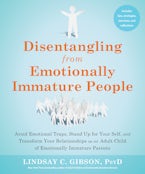By Lindsay C. Gibson, PsyD, author of Disentangling from Emotionally Immature Parents
Psychoeducation and emotional processing in psychotherapy were made for each other. They may seem to be at opposite ends of the spectrum, but they fit together hand in glove. Human beings need both for a truly effective therapy. Psychoeducation offers an intellectual framework with which to understand what has influenced one’s life, while emotional processing helps you come to grips with the feelings you have as a result. By using both, the therapist draws on the client’s rational, language-based, left-hemisphere brain and their more emotional and integrative right brain. Combining both approaches can be powerful.
It’s important to work with both sides of the brain in our clients because each aspect of the brain contributes a different strengthening effect. Psychoeducation is when we teach a client about how various psychological processes work—or why people behave as they do. With this, we together build an intellectual scaffolding that makes sense out of their experience in a very confidence-affirming way. When we understand how things work, we feel more competent and secure in our ability to predict outcomes.
But we are not machines, and the emotional processing part is necessary for clients to integrate what they learn into their deeper feelings and instincts about life. If we leave out the psychoeducation, our clients miss the pattern recognition to guide them in change—but if we leave out the emotions, they may see the pattern, but it won’t feel like it applies to them.
In working with adult children of emotionally immature (EI) parents, psychoeducation is necessary to explain the confusing interpersonal dynamics that such parents engage in. Once an adult child understands why the parent is acting that way, they can put it in the context of their parent’s psychological development and not take it so personally. Such psychoeducation can clear up years of self-doubt and feelings of not measuring up to the parent’s expectations. Experiences that once caused feelings of unlovability or unworthiness can be exteriorized and looked at objectively, allowing a client to understand what happened to them and why. People make up theories all the time about why things happen the way they do; psychoeducation gives them a chance to base these theories in science. It calms us by giving us a more fitting explanation for the reality we experienced.
But human beings understand things both intellectually and emotionally, so psychoeducation alone won’t be adequate. Clients need help exploring their feelings as well so that they understand their reactions to difficult people, and they realize how they have been affected by them. Once they fully grasp how they have been emotionally impacted, they can spot the same behavior in other people and make a choice going forward about how they are willing to be treated. Remember, while growing up we assume that everything is normal at home, and often it isn’t until a therapist encourages us to feel our feelings that we actually notice what we didn’t like and why.

Once you have formulated some understanding of a client’s story, you can ask them if you can share it with them, in the spirit of checking out your impressions. You introduce your psychoeducation topic—your theory—as a hypothesis and invite your client to say if it fits (“This is reminding me of something. Can I run some of my thoughts by you?”). This keeps you in the role of respectful collaborator and gives you the chance to test out your ideas rather than just making a pronouncement. Even when you’re pretty sure that you understand what’s going on, it’s always a good idea to present it to your client as a possibility, to offer them the chance to show you if it clicks for them. Psychoeducation is only as good as the person who’s ready for it.
Teaching clients about psychological ideas is an important aspect of building a new personal narrative that explains to a person why they feel the way they do. But all your explanations and hypotheses still need to be confirmed through the emotional work, because that is where the truth reveals itself. If a realization doesn’t touch a client’s feelings, it remains a sterile idea. Helping them to connect with the feelings of what happened to them brings back parts of themselves that may have been too sad or too shocked to process the experience originally. As you encourage getting in touch with experiences and emotions, you show your client what real emotional intimacy feels like. The way you welcome their feelings will become a model for their own eventual self-acceptance.
Combining psychoeducation with emotional processing gives your client complementary kinds of therapeutic insights that will help them both cognitively and emotionally. When you want to reach your client at the deepest levels, make sure you promote a multidimensional understanding that includes both the intellectual and the experiential. When you combine these aspects, you are facilitating your client’s growth and change at multiple levels, bringing the most powerful parts of their minds together for the best possible outcome.
Lindsay C. Gibson, PsyD, is a clinical psychologist in private practice who specializes in individual psychotherapy and coaching with adult children of emotionally immature parents. She is author of Adult Children of Emotionally Immature Parents, Recovering from Emotionally Immature Parents, and Self-Care for Adult Children of Immature Parents.



 Part 2: What to Do When a Client Is Participating in Self-Judgment?
Part 2: What to Do When a Client Is Participating in Self-Judgment?